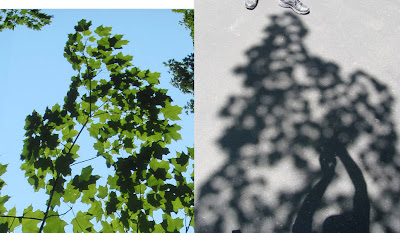On a recent sunny day, I noticed this pattern of light and shadow cast across a road. The shadow looked like a piece of dark paper with holes punched out of it.

The circles of dappled light were about three inches in diameter, and they were all of constant size. However some circles were brighter than others.

I looked up to see what was casting the shadow. It was a maple branch 18 feet above the ground. The branch presented a fairly flat projecting surface with a fixed distance from the ground. This is why the circles were the same size.
Typically a tree or a forest presents a variety projecting of surfaces positioned at many different distances from the ground, so the circles or ellipses vary in size and focus. The farther from the ground, the larger—and blurrier—the circles.
I wondered if I could match up the projecting surface of leaves with the pattern on the ground.

It's a pretty close fit, but doesn't match exactly because they aren't shot at exactly opposite angles. At the bottom of the photo on the right you can see the sharp cast shadow of my arms holding up the camera.
Anyway, it's clear that every opening in the leafy surface, regardless of its size or its ragged shape, has its corresponding circle or composite blob of light on the ground.
The branches aren't thick enough to block the sun from that distance, so they disappear completely in the shadow.
Previously on GJ: Dappled light
More information about natural light effects in my book "Color and Light"
Không có nhận xét nào:
Đăng nhận xét